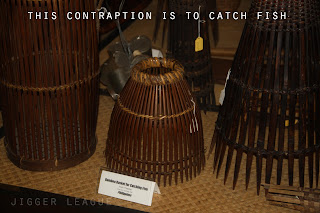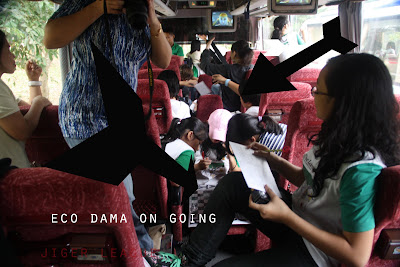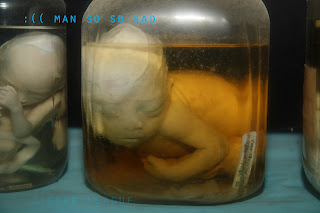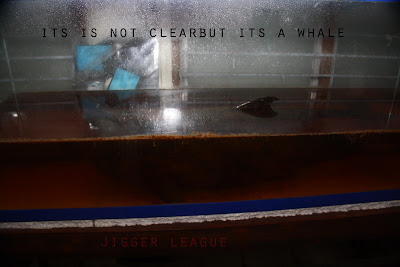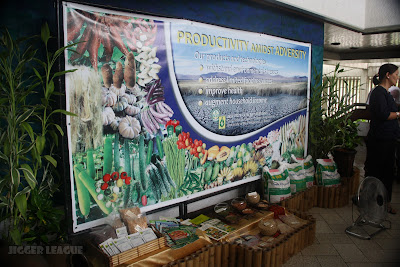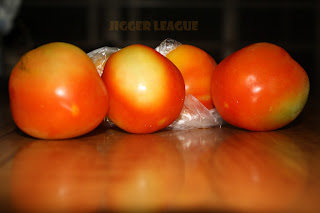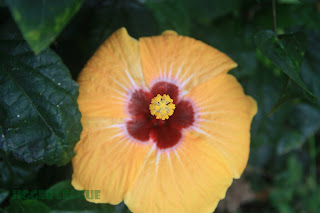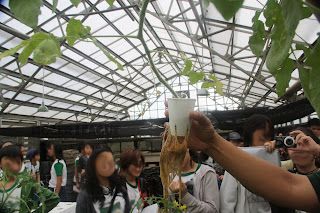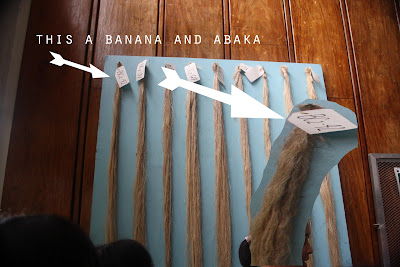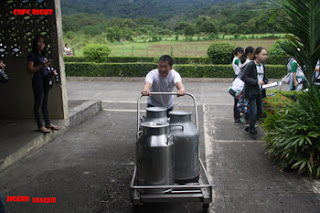Well, dear readers, here is the final installment in our Science CEO: The Blogging Project. It was a project to share aimed to share our knowledge in Science (plus our adventures) via the worldwide web. This has been more than a class activity, and it's worth more than grades. A whole lot more. This is a way we can share and express with the world what WE think, because it's worth something.
Beforehand, our group, RECaJiInna, talked about how we were going to do this project. We had to decide on a name for our blog, which had to be unique and at the same time describe each of us in our group. We decided that a mash-up of our names would be the easiest way to do that. Then we had to communicate with each other the tasks we were assigned to do to make this blog look GOOD. Everyone in the group needed to participate actively so that he/she may have a part in the blog as an important member.
At first, we encountered the amateur mistakes because we were new to this whole blogging thing. We explored the things we could do with the layout and finally, we became familiar with the settings. Our main problem for the blog was when we didn't understand what the other members were doing, and bad communication usually leads to problems. We fixed these problems later on as we had group discussions, either through YM conferences or face-to-face in school. We were able to edit our mistakes, typos and grammar errors thanks to comments from other groups and our teacher. Thankfully, we made it through! And, voila! We present our blog!
If we were asked to do this again, we would agree to do it in a heartbeat. No hesitation! This is F-U-N! And it's the type of intelligent fun you find in a learning experience like this! You can learn something new, you can express what your feeling, you get to explore the world (and your computer) and you bond with your friends. We would definitely do this again, and we think future batches would enjoy doing this too!
We don't really think the way the CEO was handles should be changed. It was an organized method, and we easily knew what we were supposed to be writing about and who we should be commenting on by just visiting http://sciencebloggingproject.blogspot.com/
The most important thing we learned in this project is to be sincere. Trust in God, and he'll lead you to success! We are all different, and there's no reason to hide that. We each have our own beliefs, and even if given the same topic, we'll each have a different way on how we interpret that. But no matter how different we are, we all fit together.Doing this blog, as well as reading the other groups' blog, helped us understand that.
And so, thank you to everyone out there who's supported us and read our blog! We hope you learned as much as we have in this experience, and we hoped you enjoyed the ride! Thank you to everyone who voted for RECaJinna, it really meant a lot to us!
Thank you VERY MUCH to Teacher Rye for giving us this experience, as well as all the others. Sir, thank you for putting up with our noise and times we were extremely annoying. Thank you for teaching us Science in a way which would make us remember what we learn. Thank you for the FIELDTRIP to UPLB, thank you for the lectures, thank you for helping us grow. But most of all, sir, thank you for believing in us, even though sometimes we ourselves would not. You've been a great teacher, and you've helped make our final crusade here at the TLT one of the best times of our lives. We'll really miss you, Sir.
RECaJiInna
Hello guys the votings are over and are place was 6th place thats good. Our total vote from Face Book and The blogging project is 84 +14=98 party yeah .We also thank The lord for this rank or place.we would like to congratulate blogitty Blog-blog who won to see more details go to this link http://sciencebloggingproject.blogspot.com/2011/03/peoples-choice-criteria.html
Saturday, March 19, 2011
Friday, March 11, 2011
6th Graders Vs. Steps
During our field trip, one of our stops was at the Makiling Botanical Gardens, which is located in the University of the Philippines Los Baños. More specifically, you can find the Makiling Botanical Gardens (MBG) at the slope of Mt. Makiling. And so, what is this place? It’s a protected sanctuary for flora and fauna. There, you can find a large tract of tropical forests, endemic and exotic plants, creeks and waterfalls, a wildlife collection, and a center for Philippine raptors (birds of prey, in case you didn’t know). Did we mention it also has picnic areas? Well, it does.
Before we entered MBG, we weren't expecting a hike. We thought we would be in an enclosed area where a scientist or someone would just tell us about the history of MBG and bring some plant examples. We were WRONG! We really had a lot of exercise. Phew, just remembering that is tiring! We walked more than a hundred steps of stairs as we toured the garden area. Well, walking is healthy. But the scenery sure was beautiful! There were so many different species of plants, each kind unique.
Through the experience at the Makiling Botanical Gardens, we learned that nature is something that is truly indescribable. It's just so diverse, and no specie is the same with another. That's why we have to protect every type of organism on this planet. All of them have a purpose in the world, no matter how big or small.
Name
- Common Name: Kapa- kapa
- Scientific Name: Medinilla magnifica
- Classification: Kingdom Plantae, Division Angiospermophyta
Characteristics
- Evergreen shrubs
- Leaves are opposite or whorled, or alternate in some species
- Flowers are either pink or white in color
- Producer
- Autotroph
Name
- Common Name: Red Lauan
- Scientific Name: Shorea teysmanniana
- Classification: Kingdom Plantae, Division Angiospermophyta
- Woody trunk
- Can grow to be very tall
- Producer
- Autotroph
And that's the end of our field trip. All our expectations were met. Actually, they were better than what we expected! After we went home, we were sad because we didn't want this fun day to end, but we were happy that we got to go through it.
The greatest lesson we learned here is that field trips can be used as bonding time for you and your friends. You might realize that they're actually like family. We also learned very important stuff about nature, dairy, and stuff about each other too. We're really grateful to Teacher Rye and the School for this truly memorable experience. We will never forget this experience because it was an amazing experience, and we grew in some way after we went through it.
That's it for post 8, folks! Please check out the other posts regarding not only the field trip, but the other posts as well! We're nearing the end (this is the second to the last post)!
-RECaJiInna
Hehehehe that is nice .
We're one big family.
That's a picture of all of our (unbiological) brothers and sisters
We salute you Sir Rye,teachers and kuya for supporting us, and letting us experience such a wonderful field trip!
Thank you for reading this hope you had a great time reading this and we still have one last post before we end this.But, fear not! This blog shall live forever!
REFERENCES:
IRRI WORLD OF RICE!
Oh, Hello there! For this post, we will be talking about the fourth site we went to during our feld trip to UP Los Banos, Laguna, the IRRI, or the International Rice Research Institute. Here are some facts about the IRRI:
- The mission of the IRRI is:
- to reduce poverty and hunger
- improve the health of rice farmers and consumers
- ensure environmental sustainability through collaborative research, partnerships, and the strengthening of national agricultural research and extension systems
- Reduce poverty through improved and diversified rice-based systems.
- Ensure that rice production is sustainable and stable, has minimal negative environmental impact, and can cope with climate change.
- Improve the nutrition and health of poor rice consumers and rice farmers.
- Provide equitable access to information and knowledge on rice and help develop the next generation of rice scientists.
- Provide rice scientists and producers with the genetic information and material they need to develop improved technologies and enhance rice production .
Rice
Common Name: Rice
Scientific Name: Oryza Sativa
Classification: Division Angiospermophyta
In the IRRI, we learned about rice, the tools they use in cultivating rice, and how they help the other farmers nationwide and globally.
Here are some pictures of tools used for collecting rice
Before we were sent to the museum, we were first brought to an auditorium were we watched a short-ish long video that talked about what the IRRI does, and who the IRRI helps. In that video the IRRI also teached us how to take care of plants and how to see if the rice plant is already ready to be harvested.
The lunch and game at the crammed bus beside the museum
Well well well. its lunch break in the crammed bus. Unfortunately it was drizzling outside so we had to eat inside the bus. We were also supposed to play the 3rd Eco Dama game outside, but for the same situation, we had to continue the game.. inside the bus.
here is a picture of the ongoing ECOdama game
well after all those we went to the MUSEUM OF NATURAL HISTORY. Luckily, the drive was only 2 minutes away.
The museum was built on September 30, 1976 it consists of preserved biological and zoological specimens, wood samples; by-products of microorganism, and also thousands of living plants/trees maintained in a separate location. This museum also serves as a reference for science and a center for documentation, research, and information.
A preserved monkey and a human baby.
Some organisms from The Museum of Natural History.
Name:
Common Name: Cave microbes
Scientific Name Chemo Heterotrophs
Classification: Bacteria
Characteristics:
Unseen by the naked eye.
Ecological relationship:

http://www.nps.gov/tica/naturescience/otherlifeforms.htm
Name
common name: Cave Fungi
Scientific name: Plasmodium
classification: Fungi
Characteristics:
Name
Common name: Brushland ringed mushroom
Scientific name: Agicarus
Classification: Fungi
Characteristics:
Name
common name: Cave Bacteria
scientific name: Speleothem
Classification: Bacteria
Characteristics:

here is a picture of the ongoing ECOdama game
well after all those we went to the MUSEUM OF NATURAL HISTORY. Luckily, the drive was only 2 minutes away.
The museum was built on September 30, 1976 it consists of preserved biological and zoological specimens, wood samples; by-products of microorganism, and also thousands of living plants/trees maintained in a separate location. This museum also serves as a reference for science and a center for documentation, research, and information.
A preserved monkey and a human baby.
In this museum we learned lot of things like Beetles,wasps,bees,butterfly,preserved babys snakes and other mammals there is even a baby whale, worms hook worms and others. If you are planing to go there you got to be early so you could see every thing.their are also stuffed animals birds and as skeleton of whale and land mammal which we do not know
Some organisms from The Museum of Natural History.
Name:
Common Name: Cave microbes
Scientific Name Chemo Heterotrophs
Classification: Bacteria
Characteristics:
Unseen by the naked eye.
Ecological relationship:
- Heterotroph

http://www.nps.gov/tica/naturescience/otherlifeforms.htm
Name
common name: Cave Fungi
Scientific name: Plasmodium
classification: Fungi
Characteristics:
- A cellular creeping somatic phase of slime molds
- Decomposers
could not find a picture
Common name: Brushland ringed mushroom
Scientific name: Agicarus
Classification: Fungi
Characteristics:
- Grows abundantly in grassy places
- Decomposer
could not find a picutre
common name: Cave Bacteria
scientific name: Speleothem
Classification: Bacteria
Characteristics:
- Abundant in deposits of soil or sediments
- Parasite

Name
Common Name: Musky Fruit Bat
Scientific Name: Ptenochiius jagori
Classification: Class Mammalia
Characteristics:
- uses extra skin to fly
Ecological Relationship:
Name
Common Name: Cave Gekko
Scientific Name:Gekko gigantic
Classification: Class Reptilia
Characteristics:
- has scaly skin
- lives in caves
Ecological Relationship:
Name:
Common Name:Dwarf Sperm Whale
Scientific Name: Ragia Sima
Classification: Class Mammalia
Characteristics:
- it's a mammal that lives under water
- it's one of the smallest kinds of whales
Ecological Relationship: consumer
Tuesday, March 8, 2011
the trip to "INSTITUTE OF PLANT BREEDING"
Wazzup!!And now, we take you to our second destination (do not be afraid; this is not final destination). We go to IPB or Institute of Plant Breeding. Here are some facts about I.P.B.:
IPB has been at the forefront of plant breeding research and applications in the country. Now, Dr. Jose E. Hernandez serves as the director of IPB and concurrent director of the Crop Science Cluster.
IPB serves to: (1) develop new and improved varieties of important agricultural crops; (2) undertake studies in plant breeding and allied disciplines related to crop improvement; (3) systematically collect, introduce, preserve, and maintain a germplasm bank of important and potentially useful agricultural and horticultural crops; and (4) assist other agencies in the multiplication of quality seeds and vegetative materials of recommended crop varieties.
IPB now has a wide collection of germplasm that utilizes its collection for evaluation and distribution of important and potentially useful agricultural crops. The collection ensures biodiversity, making traditional and wild varieties readily available for breeding new improved varieties.
Here we will talk about our adventure. First, here are some plants we found in I.P.B:
1.Name of Organism
- Common Name: Papaya
- Scientific Name: Carica papaya L
- Taxonomic Classification: Plantae
2. Characteristics
- Sweet
- Flesh is yellow-orange
- Juicy
- Can reach up to 30 feet
3. Ecological Relationship
- Producer
- Helps cleanses the stomach;eat it before you sleep so in the morning you can go to the bathroom.
Tuesday, March 1, 2011
Post #4: Let's talk about dairy!
Hoozah! We 6th graders, from both classes Lauan and Almaciga, finally had a field trip to UBLB or University of the Philippines, Los Baños! We were able to visit five destinations when we were there. We had a field trip to UP Los Baños so we could learn about certain plants and animals. Some of which are found here, in the Philippines, and some are found in other countries. We, group 3, had a lot of expectations for the field trip. A few of those expectations being: to learn lots of new things about plants, to learn lots of new things about animals, and to have loads of fun! Even before we left for UPLB, we were already looking forward to learning lots of new stuff!
Now, from the 5 destinations we were able to visit, in this post, we will be talking about the first one that we were able to visit- The Dairy Training and Research Institute (DTRI.)
Our group, the third group, expected to learn more about milk and how to milk a cow/cattle properly. And our expectations have not been overlooked! We did learn about milk and how to milk a cow/cattle properly! We now know that we must massage the udder before milking it. Also, we learned that when you milk a cow, it can give about two liters of milk.
If you are in need of more details about cows, or cattle, please enlighten yourself with the details we have been able to provide by researching:
If you are in need of more details about cows, or cattle, please enlighten yourself with the details we have been able to provide by researching:
Organism 1:
- Name: Cow
- Common Name: Cow/cattle
- Scientific Name: Bos Taurus
- Classification: Class Mammalia
- Characteristics:
- Heavy body weight
- Has udders
- Big
- Ecological relationship:
- Consumer
- Herbivore
- Pictures:
Wednesday, February 23, 2011
Post #3: Plants, Plants, and more PLANTS!

Our 4th quarter CEO, or Creative Expansive Output, was about plants. We had to research on the Divisions we were assigned. Well, no, technically we were the ones to choose since we picked from pieces of paper... We were also given the choice to work in either pairs, groups, or individually.
Hello! Inna here! Just like our CEO last quarter, we had to report. But this time, we reported on plants. I, Inna the awesome Marquez, was the 6th to report. Therefore, I was to report on the Division Ginkgophyta which has only one species.
Hola, awesome reader of ours! It is I, Raine. As Inna mentioned above, for our Fourth Quarter CEO, we had to report. again. But this time, we reported on plants. I was the one who reported after Inna so I was the seventh to report. I reported on the oh-so-awesome-like-this-blog Division Coniferophyta, or conifers. I worked with Berry Berry Gleek of blogitty blog-blog.
Hello there friends! My name is Camille! I reported on the Division Cycadophyta, or cycads, with my other friend, Hotaru, from the Science Gurus! I was the eighth to report, just after Raine!
Hello there friends! My name is Camille! I reported on the Division Cycadophyta, or cycads, with my other friend, Hotaru, from the Science Gurus! I was the eighth to report, just after Raine!
Hi! This is Babyface, or commonly known as Jigger. I like guns and weapons and nerf guns! I also like--Oh right, back to the topic. I reported on The Division Gnetophyta, or Gnetophytes, which I had a hard time saying! I reported individually, and I was the ninth to report.
My name is Enzo. I was the second to the last to report with my groupmates, Spazmboi from Blogitty Blog-Blog and Ryuu from the Science Gurus. My topic was on the Class Monocotyledones, or Monocots.
Inna- Well, at first I thought it would be easier, since I had just learned that the Division I was reporting on only had one species. But no. It wasn't actually that easy. I worked individually; therefore, it was a little more challenging even if last quarter we all worked individually. And when I researched about it, it only had limited data in the internet. But, I searched some more... and more... and EUREKA! I found the right source!

Wheat
http://rds.yahoo.com/_ylt=A0PDoS6E1GdNz2kAL4KjzbkF/SIG=120c0gum4/EXP=1298679044/**http%3a//www.dezinerfolio.com/taxonomy/term/29
http://botit.botany.wisc.edu
Raine- For me it felt the same. Though I worked in a group, my groupmate and I kept to ourselves a lot so it was actually as if we were working individually the whole time.
Camille- I don't think it made much difference too. But my groupmate and I both worked efficiently and we were able to present quite well, so we're really happy. t was much more fun working in a pair too.
Jigger- I think it was a bit easier to prepare for this one because we already did it before.
Enzo- It was easier to prepare for this CEO because we worked in groups.
The advantages and disadvantages of working individually or in a group:
Being alone - Being alone could mean more work to do, and having no help from others. But on the plus side, if you didn't do quite well, there's no one else to blame.
Being in a group - If you work in a group, you and your groupmate/s could help each other;you'd be doing less work than if you were by yourself; and sometimes, you could finish faster. The disadvantage, though, is even if your groupmate/s didn't do anything and you did all the work, in the end, you'd all still have the same score which isn't really fair.
 |
| source: http://ts3.mm.bing.net/images/thumbnail.aspx? Did we encounter any problems during this project? Inna- Like our blog about the animals, I had the same problem: Limited data in the internet. But I was able to resolve this problem. I searched, and searched and searched until I found several sources which approved the right data. Raine- I also took a long time researching for this CEO. Almost all the websites I found contained different data from each other. But I continued searching and HUZZAH! I found the website which they all agreed with. :) Camille- Not really, no. I didn't really have problems. Jigger- I don't think I encountered any problems because I also learned alot about plants. Enzo- The only problem I encountered was that we were given very limited time for this CEO. We learned that...
Here are some facts about our topic: Ginkgophyta- Gingkophyta is represented by one living species, Ginkgo biloba. This species is restricted to China where it may be extinct in the wild. The group was well represented during the Mesozoic with worldwide distribution.Today, Ginkgo biloba is widely planted as an ornamental.  Ginkgo biloba Gnetophyta- Gnetophytes include three extant families and four genera. This lineage dates back only to the early Cretaceous in the fossil record and is widely considered to be the closest extant relative of the flowering plants.  Welwitschiales http://images.search.yahoo.com Cycadophyta- Cycads are a division or seed plants made up of only three living families. They are now of greater interest for their uniqueness than for their ecological or economic importance. Members are scattered around the globe but are restricted to tropical or subtropical climates. |
Pinus resinosa
Monocotyledones- Monocotyledons are one of the most distinctive major lineages of angiosperms and traditionally have been paired with the Dicotyledons as the two main groups of flowering plants. Among the monocots are some of the largest families of angiosperms as well as some of the most economically important species of plants. Numerous vegetation types are dominated by monocots including grasslands, palm savannas, sedge meadows, and cattail marshes.
Monocotyledones- Monocotyledons are one of the most distinctive major lineages of angiosperms and traditionally have been paired with the Dicotyledons as the two main groups of flowering plants. Among the monocots are some of the largest families of angiosperms as well as some of the most economically important species of plants. Numerous vegetation types are dominated by monocots including grasslands, palm savannas, sedge meadows, and cattail marshes.

Wheat
P.S: We hope you like this blog post and we also hope that you have learned a lot! Please keep visiting RECaJiInna! Bye for now!
REFERENCES:
http://thingswholesale.com/ginkgo-biloba-tree.phphttp://rds.yahoo.com/_ylt=A0PDoS4J02dNo2EAsYejzbkF/SIG=133h9v416/EXP=1298678665/**http%3a//www.impactlab.net/2010/08/29/scientists-crack-the-genetic-code-of-wheat/
http://tejiendoelmundo.wordpress.com/2010/01/14/planta-ornitorrinco-la-planta-a-la-que-le-crecen-dos-hojas-cada-siglo/http://rds.yahoo.com/_ylt=A0PDoS6E1GdNz2kAL4KjzbkF/SIG=120c0gum4/EXP=1298679044/**http%3a//www.dezinerfolio.com/taxonomy/term/29
http://botit.botany.wisc.edu
http://botit.botany.wisc.edu/courses/systematics/Phyla/Coniferophyta/Coniferophyta.html
http://en.wikipedia.org/wiki/Pinophytahttp://images.search.yahoo.com/images/view?back=http%3A%2F%2Fimages.search.yahoo.com%2Fsearch%2Fimages%3Fp%3Dpinus%2Bresinosa%26b%3D41%26ni%3D20%26ei%3DUTF-8%26xargs%3D0%26pstart%3D1%26fr%3Dsfp%26fr2%3Dtab-web&w=464&h=400&imgurl=www.uwgb.edu%2Fbiodiversity%2Fherbarium%2Fgymnosperms%2Fpinres_cone01web400gf.jpg&rurl=http%3A%2F%2Fwww.uwgb.edu%2Fbiodiversity%2Fherbarium%2Fgymnosperms%2Fpinres01.htm&size=49KB&name=Trees+of+Wiscons...&p=pinus+resinosa&oid=9db793529fac47d5fae32ddfc32900dc&fr2=tab-web&no=52&tt=2230&b=41&ni=20&sigr=123foqjd2&sigi=12918d54a&sigb=13l8t32b5&.crumb=60Ws/wG22pR
Subscribe to:
Posts (Atom)







